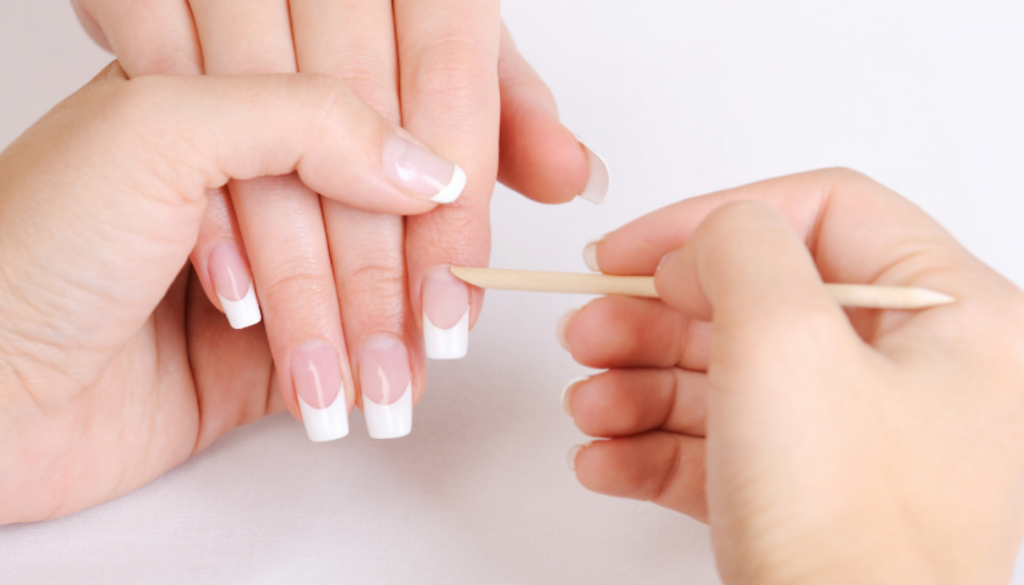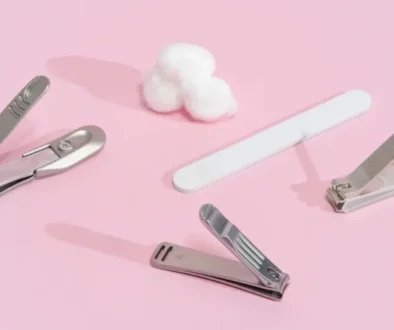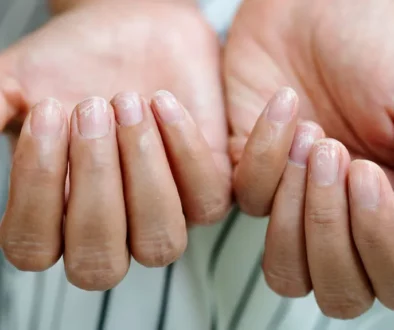Gel Nails vs. Acrylic Nails: Pros and Cons
In recent years, the world of nail enhancements has seen an unprecedented surge in popularity. When exploring the world of nail enhancements, the debate often centers around “Gel Nails vs. Acrylic Nails,” each offering distinct advantages and considerations.
Let’s delve into the pros and cons of each to help you make an informed decision for your next salon visit.
Understanding Gel Nails
Gel nails have become a popular choice among individuals seeking beautiful and durable nail enhancements. Understanding the composition and application process, as well as the pros and cons, is crucial for making an informed decision about whether gel nails are the right fit for you.
Composition and Application
Gel nails are made from a gel-like substance that is applied to the natural nails. This gel is then cured or hardened under a UV light. The process typically involves applying the gel in layers, with each layer being cured under the UV light before the next one is added. This meticulous layering creates a glossy and flexible finish that closely resembles natural nails.
Durability and Flexibility Benefits
One of the standout features of gel nails is their impressive durability. Gel nails are known for being long-lasting and chip-resistant, making them an excellent choice for individuals who lead active lifestyles. The flexibility of gel nails adds to their durability, as they are less prone to cracking or breaking compared to some other nail enhancement options.
Natural Look and Feel
Gel nails offer a natural look and feel that many individuals appreciate. The thin and flexible nature of the gel allows for a more realistic appearance, closely mimicking the texture and appearance of natural nails. This characteristic makes gel nails a popular choice for those who want an elegant and understated look.
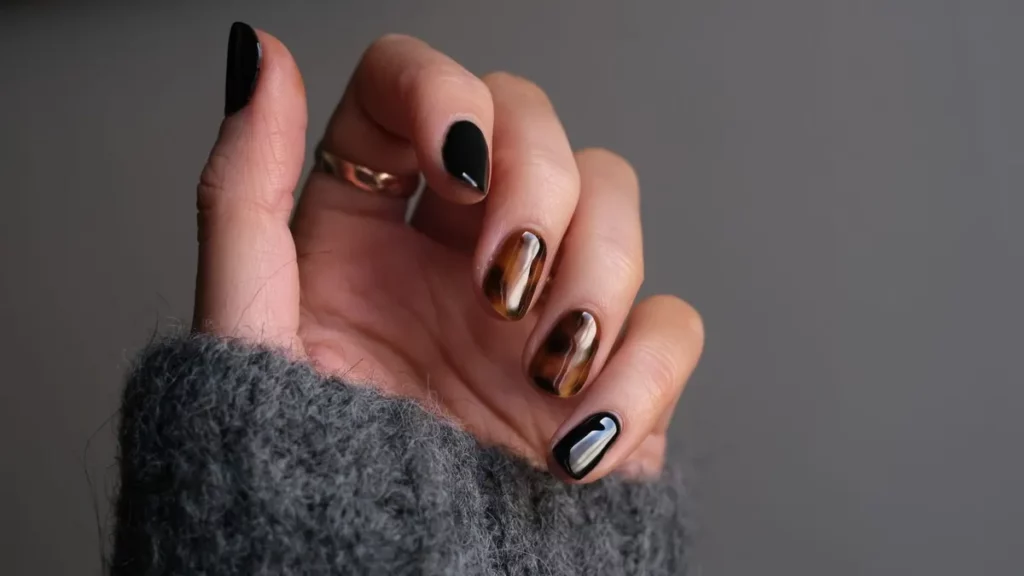
Pros of Gel Nails
- Long-lasting and Chip-resistant: Gel nails are renowned for their durability, staying chip-free for an extended period.
- Quick and Odorless Application: Unlike some other nail enhancement options, the application of gel nails is quick and virtually odorless. This makes the experience more pleasant for individuals sensitive to strong odors.
- Suitable for Various Nail Art Designs: The flexibility of gel nails allows for intricate nail art designs. Whether you prefer a simple and classic look or something more elaborate, gel nails provide a versatile canvas.
Cons of Gel Nails
- Cost Considerations: While gel nails offer many benefits, they can be more expensive than some alternative options. The cost may vary depending on factors such as the salon, the expertise of the technician, and the specific products used.
- UV Light Exposure Concerns: The curing process of gel nails involves exposure to UV light. While this exposure is generally minimal, some individuals may have concerns about the potential impact on skin health. It’s advisable to use sunscreen or UV-protective gloves during the curing process.
- Challenging Removal Process: Removing gel nails can be more complex than removing other types of nail enhancements. Professional assistance is often recommended to ensure the safe and proper removal of gel nails without causing damage to the natural nails.
Exploring Acrylic Nails
Acrylic nails have long been a classic choice for individuals seeking durable and versatile nail enhancements. Let’s delve into an overview of acrylic nails, examining their composition, strengths, and the unique advantages they offer, as well as considering the potential drawbacks.
Overview of Acrylic Nails and Their Composition
Acrylic nails are crafted using a mixture of liquid monomer and powder polymer. When combined, these elements create a pliable substance that can be shaped and molded onto the natural nails. Once applied, the acrylic mixture hardens to form a resilient and long-lasting surface.
Strength and Versatility Advantages
One of the key attractions of acrylic nails lies in their inherent strength. Acrylic enhancements are robust and durable, making them an excellent choice for individuals who engage in activities that may subject their nails to wear and tear. The sturdy nature of acrylic nails provides a protective layer, reducing the risk of breakage and chipping.
Traditional Appeal
Acrylic nails boast a traditional appeal that has stood the test of time. Their classic and timeless look makes them a popular choice for individuals who prefer a more understated and elegant appearance. The versatility of acrylic nails allows for various shapes and lengths, catering to a wide range of style preferences.
Pros of Acrylic Nails
- Affordability and Accessibility: Acrylic nails are generally more budget-friendly compared to some other nail enhancement options. This affordability makes them accessible to a broader audience.
- Robust and Durable: The strength of acrylic nails is a significant advantage, providing durability that withstands daily activities and potential impacts.
- Easy Maintenance and Removal: Acrylic nails are relatively easy to maintain and remove. Regular maintenance involves fills to keep the nails looking fresh, and removal is a straightforward process that can be done by a professional technician.
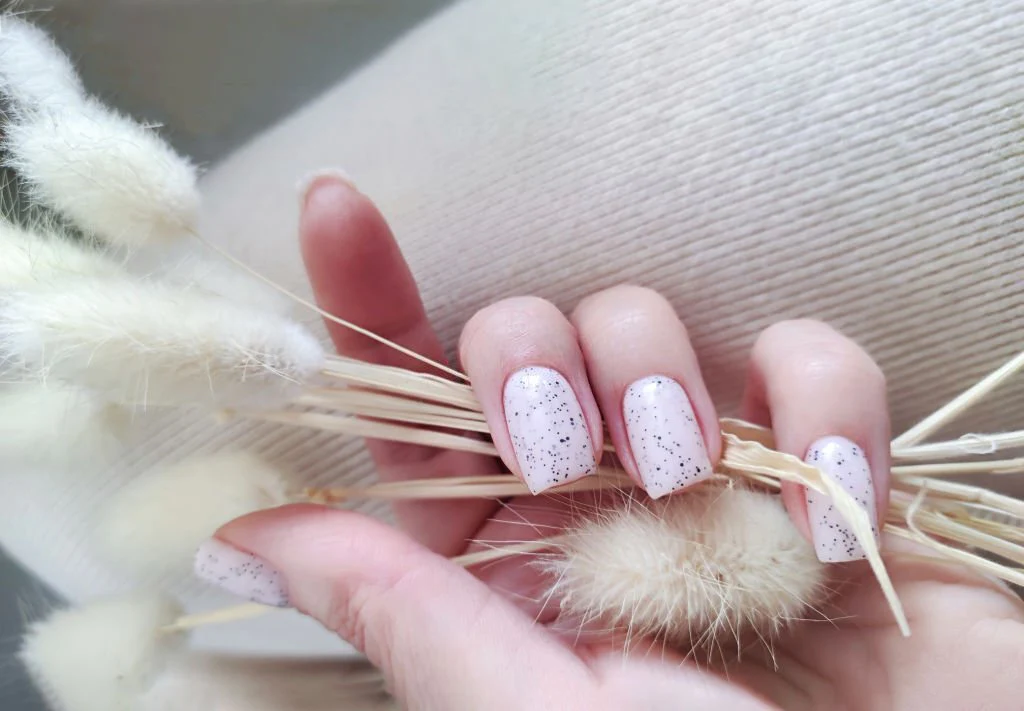
Cons of Acrylic Nails
- Potentially Harsh Chemicals: The application process of acrylic nails involves the use of liquid monomer, which can emit strong odors and may contain potentially harsh chemicals. Individuals with sensitivities or allergies should be cautious and considerate of these factors.
- Thickness and Heaviness: Acrylic nails can feel thicker and heavier than some other options, affecting the overall comfort of some individuals. This thickness is a result of the layering process during application.
- Prone to Lifting and Discoloration: Over time, acrylic nails may be prone to lifting from the natural nail bed, creating space for water or debris to accumulate. Additionally, acrylic nails can sometimes undergo discoloration, requiring prompt attention and maintenance.
Comparing Durability
When it comes to nail enhancements, durability is a crucial factor influencing the choice between gel and acrylic nails. Let’s dive into an in-depth analysis of the durability of these two popular options and explore the various factors that play a role in determining how long each type can maintain its pristine appearance.
In-Depth Analysis of Gel and Acrylic Nails’ Durability
Gel Nails
Gel nails are celebrated for their flexibility, which contributes significantly to their durability. The flexible nature of the gel allows the nails to withstand everyday activities without succumbing to chips or cracks. However, it’s important to note that the level of durability can vary depending on the quality of the gel used and the application technique.
Acrylic Nails
Acrylic nails, known for their strength and resilience, offer a different kind of durability. The robust composition of the acrylic mixture provides a solid layer that can withstand impacts and daily wear. Like gel nails, the longevity of acrylic nails is influenced by the skill of the technician and the quality of the materials used.
Factors Influencing the Longevity of Each Type
- Nail Technician Expertise: The skill and experience of the nail technician play a crucial role in determining how long both gel and acrylic nails will last. A well-executed application ensures the longevity of the enhancements.
- Product Quality: The quality of the gel or acrylic products used during the application process directly impacts durability. Higher-quality products tend to result in longer-lasting nail enhancements.
- Maintenance Routine: Regular maintenance, including fills and touch-ups, is essential for prolonging the life of both gel and acrylic nails. Following the recommended care routine will contribute to sustained durability.
- Daily Activities: Individual lifestyles and daily activities can affect the durability of nail enhancements. Those with more physically demanding routines may find that one type of enhancement suits their lifestyle better than the other.
- Post-Application Care: Following proper post-application care instructions, such as avoiding excessive exposure to water and using gloves during household chores, can significantly impact how well gel and acrylic nails hold up over time.
Aesthetics and Customization
Beyond durability, the visual appeal and customization options are key considerations when choosing between gel and acrylic nails.
Gel Nails
Gel nails are celebrated for their natural and glossy finish. The thin layers of gel create a look that closely resembles natural nails, providing an elegant and understated aesthetic. The glossy appearance adds a touch of sophistication.
Acrylic Nails
Acrylic nails offer a classic and versatile look. Their thicker and more substantial nature allows for a range of shapes and lengths. The traditional appeal of acrylic nails makes them a timeless choice for those who prefer a polished and well-groomed appearance.
Discussing the Versatility of Creative Nail Designs
Gel Nails
The flexibility of gel nails makes them an ideal canvas for creative and intricate nail designs. Whether you opt for subtle patterns, vibrant colors, or 3D nail art, gel nails provide a smooth and even surface for artistic expression.
Acrylic Nails
Acrylic nails, with their sturdy structure, allow for various creative possibilities. From bold and dramatic designs to unique shapes, acrylic nails provide ample room for customization. The versatility of acrylic nails makes them a favorite for those who love experimenting with different looks.
Health Considerations
While the aesthetic appeal and durability of gel and acrylic nails are essential, it’s equally important to consider their impact on natural nail health and potential health concerns.
Impact of Both Types on Natural Nail Health
Both gel and acrylic nails, when applied and maintained correctly, generally do not cause significant harm to natural nails. However, improper removal or neglecting proper care routines can lead to issues such as thinning or weakening of the natural nails. Regular breaks between applications are recommended to allow natural nails to breathe and recover.
Allergies and Sensitivities Associated with Gel and Acrylic Nails
Individuals with allergies or sensitivities to certain chemicals should exercise caution when opting for gel or acrylic nails. Some individuals may experience adverse reactions to the chemicals used in these nail enhancement processes. It’s crucial to communicate any allergies or sensitivities with your nail technician to ensure the use of suitable products.
Application Process
Step-by-Step Guide to Applying Gel Nails
-
Nail Preparation:
- Begin by cleaning and shaping the natural nails.
- Gently push back the cuticles for a neat appearance.
-
Base Coat Application:
- Apply a thin layer of gel base coat evenly on each nail.
- Ensure the base coat is cured under UV light to create a solid foundation.
-
Gel Color Application:
- Choose the desired gel color and apply it in thin, even layers.
- Cure each layer under the UV light to achieve the desired opacity.
-
Additional Layers (if needed):
- Repeat the application process for additional layers until the desired color intensity is achieved.
-
Top Coat Application:
- Apply a gel top coat to seal the color and provide a glossy finish.
- Cure the top coat under the UV light for a lasting shine.
-
Final Touches:
- Cleanse the nails to remove any residue.
- Moisturize the cuticles for a polished look.
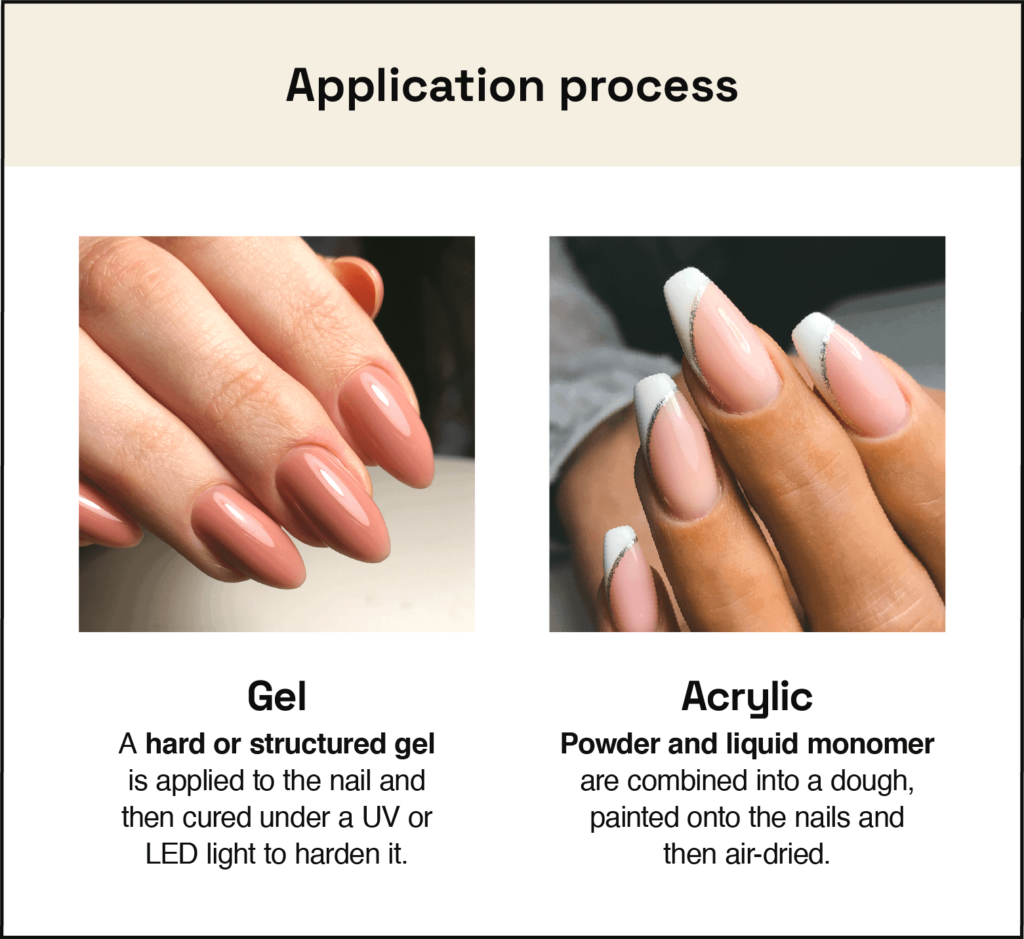
Step-by-Step Guide to Applying Acrylic Nails
-
Nail Preparation:
- Begin by cleaning, shaping, and buffing the natural nails.
- Apply a dehydrator to remove excess oils and promote adhesion.
-
Tip Application:
- Choose the appropriate nail tips and apply them to the natural nails using acrylic adhesive.
- Trim and shape the tips according to the desired length and style.
-
Acrylic Mixture Application:
- Prepare the acrylic mixture by combining liquid monomer and powder polymer.
- Use a brush to apply the acrylic mixture over the nail tips, sculpting the desired shape.
- Allow the acrylic to air-dry or cure under a fan.
-
Filing and Shaping:
- Once the acrylic has dried, file and shape the nails to achieve the desired look.
- Smooth the surface for a natural finish.
-
Buffing and Polishing:
- Buff the nails to remove any imperfections and create a smooth texture.
- Polish the nails for a glossy finish.
-
Final Touches:
- Cleanse the nails to remove any dust.
- Moisturize the cuticles to complete the application process.
Maintenance Routine
Recommended Care for Gel Nails
- Avoid Excessive Water Exposure: Prolonged exposure to water can weaken gel nails. Use gloves during activities like washing dishes.
- Regular Moisturizing: Keep cuticles and surrounding skin moisturized to maintain a healthy appearance.
- Gentle Nail Care: Avoid using the nails as tools to prevent chipping or lifting. Be cautious with activities that may impact the nails.
- Regular Fills: Schedule regular fills to maintain the integrity of the gel nails and keep them looking fresh.
Recommended Care for Acrylic Nails
- Regular Fills:
-
-
- Schedule regular fills to fill in the gap between the acrylic and natural nails.
- This helps prevent lifting and maintains the overall look.
-
- Avoid Harsh Chemicals: Protect acrylic nails from direct contact with harsh chemicals, as they can cause damage or discoloration.
- Gentle Nail Care: Treat acrylic nails with care to prevent breakage. Avoid using them as tools in strenuous activities.
- Moisturize Cuticles: Regularly moisturize cuticles to keep the nails and surrounding skin healthy.
Cost Comparison
Gel Nails
-
Materials:
- Gel base coat, color gel, top coat
- UV light for curing
- Cleansing supplies
-
Professional Service:
- Technician fees for application and maintenance.
Acrylic Nails
-
Materials:
- Nail tips, acrylic powder, liquid monomer
- Adhesive for tips
- Filing and buffing tools
-
Professional Service:
- Technician fees for application and fills.
Factors Influencing the Overall Expenses
- Salon Location: Costs may vary depending on the geographical location and the pricing standards of the salon.
- Technician Expertise: Experienced technicians may charge higher fees for their skills.
- Product Quality: Higher-quality gel or acrylic products may come with a higher price tag.
- Additional Services: Nail art, designs, or additional services may incur extra charges.
Conclusion
In summary, the choice between gel and acrylic nails depends on individual preferences, lifestyle, and budget considerations. Both options offer unique benefits and aesthetics, and understanding the application processes, maintenance routines, and associated costs allows individuals to make informed decisions. Whether opting for the flexibility of gel nails or the classic appeal of acrylic nails, the key is to prioritize proper care for long-lasting and beautiful results. Remember to consult with a professional nail technician for personalized advice tailored to your specific needs and preferences.
Also Read:
The Ultimate Guide to Glowing Skin: Tips and Tricks
